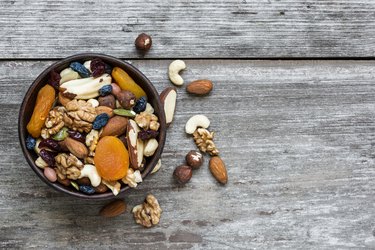
The nuts you buy may sport a health claim approved by the American Heart Association which notes that eating 1.5 ounces of nuts daily may reduce your risk of heart disease. The statement holds true for peanuts and almonds, but beyond their cardiovascular benefits, they each provide different amounts of vitamins and minerals. Peanuts have more B vitamins, but almonds are a better choice for vitamin E and minerals.
Nutritional Value of Peanuts vs. Almonds
Video of the Day
When it comes to macronutrients, it doesn't matter whether you eat peanuts vs. almonds because they're almost equal. The protein in almonds amounts to 6 grams in a 1-ounce serving. Almonds have 170 calories and 3 grams of fiber per ounce, says USDA National Nutrient Database.
Video of the Day
There are 166 calories in peanuts and 2 grams of fiber, according to USDA National Nutrient Database. The protein in peanuts is about 7 grams per serving. A 1-ounce serving of nuts depends on the size of the nuts but is usually described as one handful. Cleveland Clinic notes that a 1-ounce serving is 24 whole almonds and 35 peanuts.
Read more: Side Effects of Eating Too Many Peanuts
Both Contain Healthy Fat
The difference in fat content is minimal. Almonds have 15 grams, and peanuts contain 14 grams of total fat in a 1-ounce serving. A large percentage of the fat — 80 percent in peanuts and 88 percent in almonds — consists of unsaturated fats,
These healthy fats lower your risk of cardiovascular disease by reducing levels of cholesterol in your blood and fighting inflammation says Harvard Health. About 20 percent to 35 percent of your daily calories should come from fats, with as much as possible coming from unsaturated fat, according to Harvard Health.
Read more: Side Effects of Eating Too Many Almonds
Differences in Vitamins and Minerals
Almonds and peanuts contain the same vitamins but in different amounts. Almonds are the nut to choose if you need to boost your intake of antioxidant vitamin E. They have 45 percent of your recommended daily allowance in a 1-ounce serving, according to NIH, which is three times more than you'll get from peanuts.
On the other hand, peanuts are better sources of the B vitamins, especially folate and niacin. A 1-ounce serving of peanuts contains 10 percent of your RDA of folate and about 24 percent of the RDA of niacin. Almonds only have half the folate and one-fourth the niacin of peanuts.
Both types of nuts are good sources of magnesium. A 1-ounce serving of peanuts contains 12 percent of the RDA, while almonds supply 19 percent of your daily magnesium.
When foods are described as a good source of a nutrient, it means they contain 10 percent to 19 percent of the RDA, according to the USDA Dietary Reference Intakes. You'll get less than 10 percent of the RDA of calcium, potassium and zinc from 1 ounce of almonds and peanuts. Almonds, however, have two times more iron and five times more calcium than peanuts.
Watch Your Sodium Intake
You might be surprised to learn that when they're oil-roasted, peanuts and almonds only have 1 more gram of total fat than dry-roasted varieties. Peanuts don't absorb much of the oil used during roasting, notes Linda Minges, a registered dietitian with the North Carolina Cooperative Extension Service.
Nuts are naturally low in sodium, but if you buy them salted, the sodium goes up to 186 and 189 milligrams per 1-ounce serving in almond and peanuts, respectively.
- USDA Nutrient Database for Standard Reference: Nuts, Almonds, Dry-Roasted, Without Salt Added
- USDA Nutrient Database for Standard Reference: Peanuts, All Types, Dry-Roasted, Without Salt
- Office of Dietary Supplements: Vitamin E
- Harvard Health Publications: Listing of Vitamins
- North Carolina State University Cooperative Extension: Peanuts
- National Academies: Dietary Reference Intakes
- Harvard Health Publications: Fats Resource Center
- American Heart Association: Go Nuts (But just a little!)
- Harvard Health: The Truth About Fats: The Good, The Bad, and The In-between
- Cleveland Clinic:Nutrition: Nuts & Heart Health